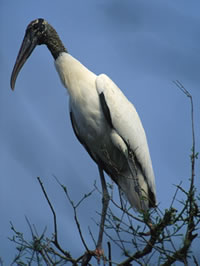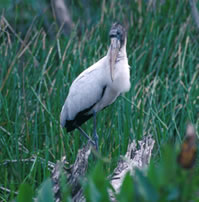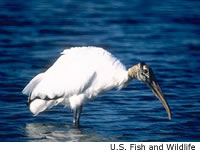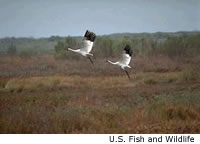Characteristics
 The wood stork is the only stork species found in North America. It is 40-44 inches in length with a wingspan of five feet. It has a naked gray to black head and neck, a white body and black edged wings and tail. It has a long, slightly curved black bill and long legs. Unlike herons, the wood stork flies with its neck stretched straight out. Males and females look alike. The wood stork is the only stork species found in North America. It is 40-44 inches in length with a wingspan of five feet. It has a naked gray to black head and neck, a white body and black edged wings and tail. It has a long, slightly curved black bill and long legs. Unlike herons, the wood stork flies with its neck stretched straight out. Males and females look alike.
Range
 The wood stork breeds in Florida, Georgia and South Carolina. After the breeding season it can be found north to North Carolina and west to Mississippi. The wood stork is on the U.S. Endangered Species List. It is listed as endangered in Alabama, Florida, Georgia, and South Carolina. There are about 5,000 breeding pairs in the United States. Loss of habitat is largely responsible for the decline in population. The wood stork is also found in the
Caribbean and Central and South America. The wood stork breeds in Florida, Georgia and South Carolina. After the breeding season it can be found north to North Carolina and west to Mississippi. The wood stork is on the U.S. Endangered Species List. It is listed as endangered in Alabama, Florida, Georgia, and South Carolina. There are about 5,000 breeding pairs in the United States. Loss of habitat is largely responsible for the decline in population. The wood stork is also found in the
Caribbean and Central and South America.
Habitat
The wood stork can be found in
coastal areas, tidal waters, marshes, swamps, streams and mangroves.
|
|
Diet
 The wood stork feeds during the day and at night. It eats
small fish, frogs, mollusks, snails, insects, and aquatic invertebrates. It hunts for its prey in shallow, muddy-bottomed banks or wetlands. The wood stork moves slowly through the shallow water with its bill open feeling for movement. When the wood stork locates a fish, it quickly snaps its bill shut. The wood stork feeds during the day and at night. It eats
small fish, frogs, mollusks, snails, insects, and aquatic invertebrates. It hunts for its prey in shallow, muddy-bottomed banks or wetlands. The wood stork moves slowly through the shallow water with its bill open feeling for movement. When the wood stork locates a fish, it quickly snaps its bill shut.
Life Cycle
Wood stork pairs often mate for life. Pairs often return to the same nesting colony site year-after-year. The nest is a platform made of sticks and places in a tree. There may be a many as 25 nests in a single tree! Both the male and the female build the nest. The female lays 2 or 3 white eggs
and both parents take turns incubating them. Incubation takes 28-32 days. Both parents feed and care for the chicks. The chicks fledge in about two months.
Behavior
 The wood storks is an excellent fliers. It soars thousands of feet in the air with its legs and neck outstretched and rides on air currents. The wood stork sometimes performs rolls and dives in flight. The wood storks is an excellent fliers. It soars thousands of feet in the air with its legs and neck outstretched and rides on air currents. The wood stork sometimes performs rolls and dives in flight.
|